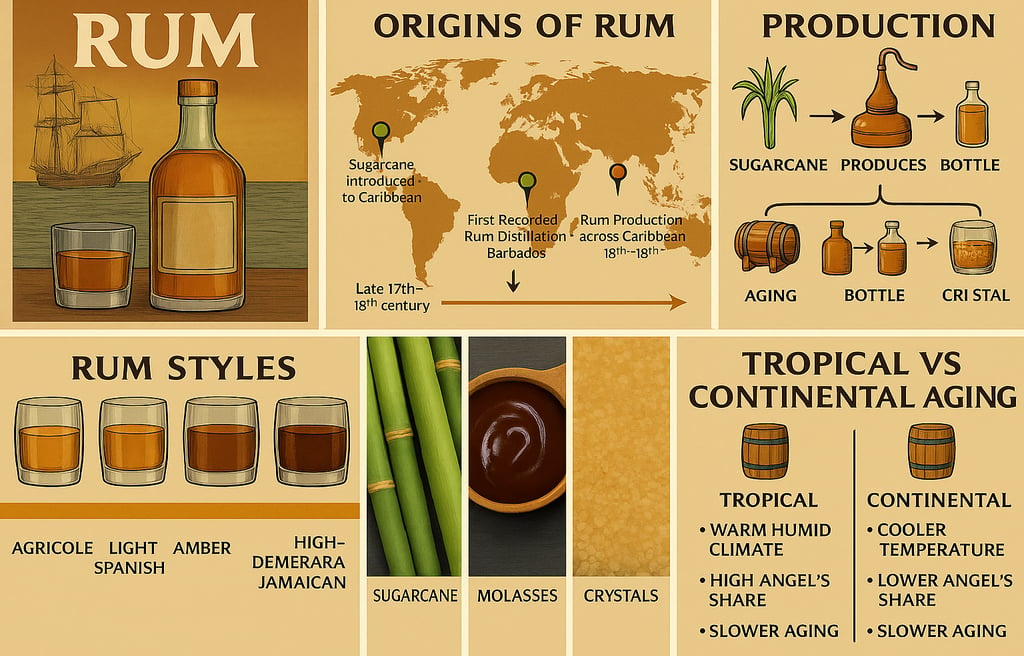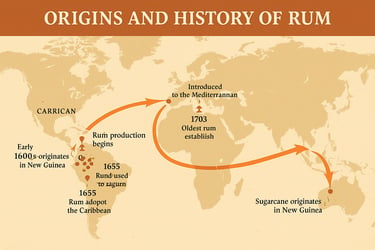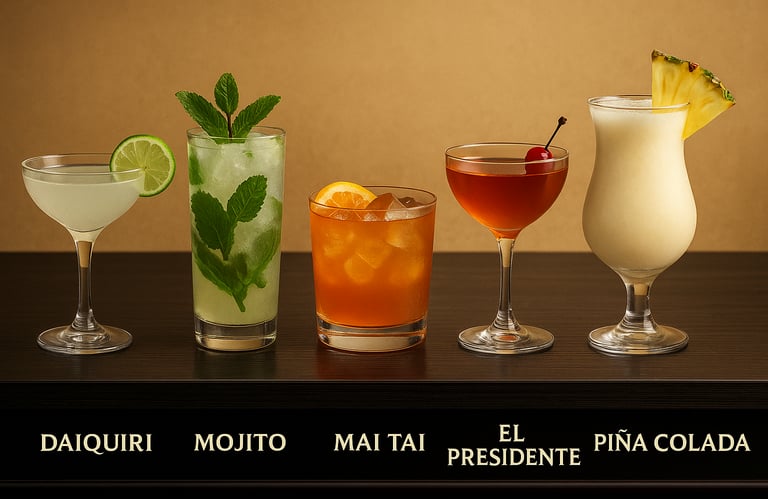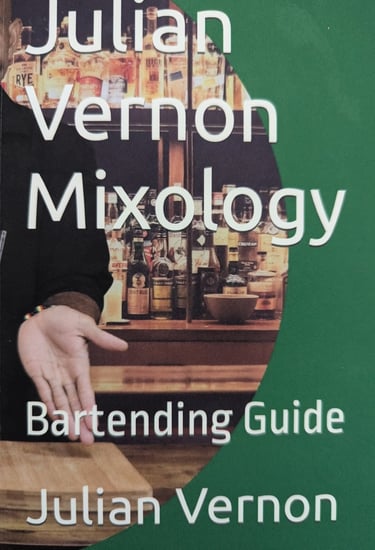The Ultimate Rum Guide: Deep History, Production, Styles & Classic Cocktails
From 17th-century Barbados to today’s craft revival, explore rum’s origins, how it’s made, regional styles (English, Spanish, French), buying tips, and essential cocktail recipes.
Julian Vernon
8/17/20255 min read


Rum: Sugarcane Soul, Island Spirit
By Julian Vernon | Cocktail A to Z
Rum is the world’s most diverse spirit—born from sugarcane, shaped by climate, and flavored by history. This guide covers what rum is, how it’s made, a deep dive into its origins and global spread, how to buy and taste it, and the classic cocktails that let each style shine.
What Is Rum?
Rum is a distilled spirit made from sugarcane—either molasses (a by-product of sugar making) or fresh cane juice—then fermented, distilled (pot or column stills), and usually aged in oak. Its spectrum runs from bright and grassy (cane-juice “rhum agricole”) to lush and funky (long-fermented molasses rums) to light and crisp (clean column-distilled rums).
History
1) Sugarcane before rum
Sugarcane likely originated in New Guinea, spreading through India and Southeast Asia to the Islamic world and Mediterranean by the Middle Ages. Europeans learned to refine sugar and, with 15th–16th century expansion, carried cane to the Atlantic islands (Madeira, the Canaries) and the Caribbean.
2) The Caribbean birth of rum
Early Caribbean distillates appear in the 17th century; in Barbados records mention “kill-devil” and “rumbullion”—early names for rum. Planters realized the molasses left over from sugar refining still contained fermentable sugars; with yeast and heat, molasses fermented readily and was redistilled for cleanliness and strength.
Rum quickly became a sailor’s staple; after England seized Jamaica (1655), the Royal Navy embraced Caribbean rum, leading to the famous daily rum ration that lasted until “Black Tot Day” on July 31, 1970.
3) Rum, trade, and early America
New England developed a robust rum industry: molasses in, rum out, intertwined with the era’s brutal Atlantic slave trade. Rum served as currency in bartering and was ubiquitous in colonial taverns.
Tensions over sugar and molasses taxation (notably the Sugar Act of 1764) helped stoke colonial grievances that fed into the American Revolution.
4) Regional traditions take shape
English-influenced islands (Jamaica, Barbados, Guyana) favored longer fermentations, pot stills, and weighty, estery styles.
Spanish-influenced producers (Cuba, Puerto Rico, Panama, Dominican Republic) leaned toward cleaner column-distilled rums—lighter, crisp, highly mixable.
French Caribbean territories developed rhum agricole—distilled from fresh cane juice, especially in Martinique, where an AOC (appellation) defines production rules.
5) 20th century to now
Prohibition in the U.S. (1920–1933) dented legal markets but boosted Caribbean supply through smuggling.
Post-Prohibition, the tiki era (1930s–1960s) in the U.S. celebrated layered rum cocktails.
Modern rum embraces transparency (age statements, additives disclosure), geographical indications (Jamaica, Martinique), and a revival of heritage pot-still techniques—while still powering beach bars worldwide.
How Rum Is Made (and What Shapes Its Flavor)
Raw Material
Molasses: caramel, toffee, tropical fruit potential.
Fresh cane juice (agricole/clairin): grassy, herbal, mineral.
Fermentation
Short & clean (12–48h): lighter rums.
Long, cultured or wild (days+), sometimes using “dunder” or muck pits: high esters, big tropical funk (notably some Jamaican styles).
Distillation
Pot stills: rich body, congeners, character.
Column stills: clean, light, consistent.
Many producers blend still types for balance.
Aging & Climate
Tropical aging: rapid extraction/oxidation; tastes “older” sooner, but higher angel’s share.
Continental aging: slower development; different oak impact.
Casks: ex-bourbon most common; also sherry, port, cognac, wine casks for finishing.
Blending & Finishing
Producers blend ages and still types; some use caramel coloring (E150a) for consistency and dosage (sweetening) for roundness—practices vary and are debated.
Rum Styles & Traditions (Quick Field Guide)
White/Blanco: clear; lightly aged and filtered or unaged; perfect for Daiquiris and Mojitos.
Gold/Amber: brief to moderate aging; soft vanilla and baking spice.
Dark: longer aging and/or heavy molasses notes; lush caramel, dried fruit.
Blackstrap: molasses-forward intensity; big cola/molasses profile.
Overproof (57–75.5%+ ABV): potent mixer, float layers, punches.
Spiced: vanilla, cinnamon, clove; sweetness varies by brand.
Agricole/Clairin: fresh cane juice; grassy, peppery, mineral; vibrant in sours and highballs.
Demerara/“Guyana” profiles: often wooden still heritage, dark fruit, licorice, resin.
Jamaican high-ester: ripe banana, pineapple, glue/varnish esters (in the best way!).
Spanish-style light rums: crisp, clean, easy-mixing.
How To Taste Rum Like a Pro
Smell in a tulip glass: sugarcane, tropical fruit, vanilla, cocoa, banana esters, baking spice.
Sip at room temp; note texture (oily vs. crisp), sweetness, and finish (dry oak vs. molasses).
Drop of water can open fruit/ester complexity.
Ice test: a single cube will emphasize oak and sweetness in aged rums; for white rums, chill before a Daiquiri test.
Buying Guide: Choose the Right Rum for the Job
Daiquiri/Mojito: clean white rum or bright agricole blanc for snap.
Old Fashioned/Rum Manhattan riffs: aged molasses rum or Demerara with structure (pot/column blends).
Tiki builds (Mai Tai, Zombie): blend funky Jamaican + nutty/dry Martinique + rounded Spanish-style for layers.
Highballs & punches: Spanish-style light or amber for easy drinkability.
Sipping neat: aged pot-still or agricole vieux; check transparent producers and age statements.
Label clues:
Geographical Indication/AOC (e.g., Jamaica, Martinique) offers guardrails.
“Solera” implies fractional aging; numbers may reflect the oldest fraction, not average age.
Additives disclosure is voluntary—seek producers who share details if you prefer drier profiles.
Classic Rum Cocktails (Bar-Ready Specs)
1) Daiquiri (Cuban-style)
2 oz white rum
¾ oz fresh lime
½–¾ oz simple syrup (1:1)
Shake hard; fine-strain to a chilled coupe; no garnish (or a lime coin).
2) Mojito (Built, Not Shaken)
2 oz white rum
¾ oz fresh lime
½–¾ oz simple (1:1)
8–10 mint leaves + soda water
Press mint gently with syrup; add rum & lime; add crushed ice, swizzle; crown with soda; mint bouquet.
3) Mai Tai (1944 Trader Vic spirit-forward spec)
1 oz aged Jamaican rum
1 oz Martinique rhum (VSOP or vieux)
¾ oz fresh lime
½ oz orange curaçao
¼ oz orgeat + ¼ oz simple
Shake; crushed ice; spent lime shell & mint. (Adjust rum split to taste.)
4) El Presidente (dry, elegant)
1½ oz light Cuban-style rum
¾ oz dry vermouth
½ oz orange curaçao
1 barspoon grenadine (true pomegranate)
Stir; coupe; orange peel.
5) Piña Colada (modern balanced)
1½ oz lightly aged rum
1 oz coconut cream
1½ oz pineapple juice
¼ oz fresh lime
Blend with pebble ice or shake hard; tall glass; pineapple frond & cherry.
6) Rum Old Fashioned
2 oz well-aged rum
¼ oz Demerara syrup (2:1)
2 dashes Angostura + 1 dash orange bitters
Stir; rocks over a big cube; orange peel.
Food Pairings
Savory Caribbean: jerk chicken, patties, curried goat—molasses depth loves char and spice.
Seafood: grilled shrimp, salt-fish fritters; squeeze of lime mirrors Daiquiri acidity.
Dessert: grilled pineapple, plantains foster, dark chocolate, coconut sweets.
FAQ (Quick Hits)
Is rum sweetened? Some rums are; look for producers who disclose additives if you prefer dry styles.
Does color equal age? Not always—caramel coloring and finishing can deepen color; verify age statements.
How long can rum keep? Essentially indefinite if sealed; once opened, store cool and dark.






Enthusiasts
© 2024. All rights reserved.


